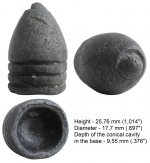Hello!
I am new here.
Some time ago I've got this lead bullet from USA. It came from California, and may be was found there.
I don't have a great experience in US Civil War bullets. I have about 20 or 30 specimens of US bullets in my collection. Here, in Ukraine we collect Crimean War bullets generally.
I suppose that this is .69 cal. Austrian 3 groove rifle|musket bullet, but I am not sure
So, please help me to make the correct identification of this bullet: caliber (.69 or .70), weapon, if possible - manufacturer and troops, which used it
Thanks for any info

I am new here.
Some time ago I've got this lead bullet from USA. It came from California, and may be was found there.
I don't have a great experience in US Civil War bullets. I have about 20 or 30 specimens of US bullets in my collection. Here, in Ukraine we collect Crimean War bullets generally.
I suppose that this is .69 cal. Austrian 3 groove rifle|musket bullet, but I am not sure
So, please help me to make the correct identification of this bullet: caliber (.69 or .70), weapon, if possible - manufacturer and troops, which used it
Thanks for any info


